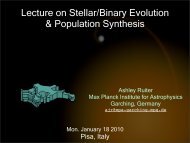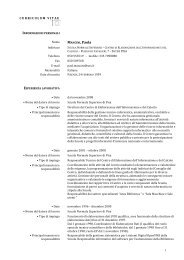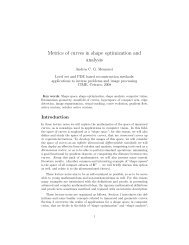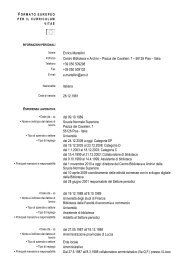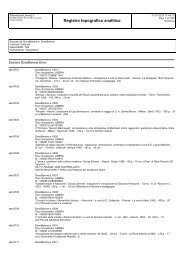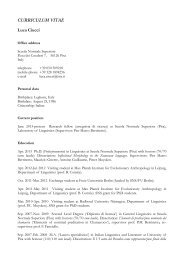Non-conventional uses of the Pluperfect entional uses of the ...
Non-conventional uses of the Pluperfect entional uses of the ...
Non-conventional uses of the Pluperfect entional uses of the ...
Create successful ePaper yourself
Turn your PDF publications into a flip-book with our unique Google optimized e-Paper software.
QUADERNI DEL LABORATORIO DI LINGUISTICA – VOL. 9,2/2010beginning such as Mary had forgotten <strong>the</strong> car’s key immediately prompts <strong>the</strong>hearer/reader to locate R at a <strong>conv<strong>entional</strong></strong> point-in-time, to be identified with <strong>the</strong>current stage <strong>of</strong> <strong>the</strong> plot, such that <strong>the</strong> event <strong>of</strong> forgetting must have occurred at someundefined moment preceding <strong>the</strong> given temporal stage.Despite <strong>the</strong> fairly robust stability <strong>of</strong> <strong>the</strong> PPF’s representation, in some languages oneobserves a growing tendency <strong>of</strong> <strong>the</strong> PPF to be used in purely aoristic contexts, i.e. asan alternative to <strong>the</strong> purely perfective Past(s). This is notably <strong>the</strong> case as far as <strong>the</strong>propulsive function <strong>of</strong> literary narratives is concerned, but <strong>the</strong> same tendency may beobserved in spontaneous oral usage. A number <strong>of</strong> examples will be provided below.This may be understood as a development subsequent – but connected to – <strong>the</strong>tendency <strong>of</strong> <strong>the</strong> present-perfect to invade <strong>the</strong> aorist’s territory This well-known drift,which might be called called “Perfektschwund”, 6 has been pointed out for severalunrelated languages and at different diachronic stages, and appears to be a sort <strong>of</strong>cognitive constant underlying <strong>the</strong> unstable relation opposing present-perfect and aorist.The delicate texture <strong>of</strong> <strong>the</strong> present-perfect, as indicating <strong>the</strong> “current relevance <strong>of</strong> apast event”, <strong>of</strong>ten tends to gradually shift into <strong>the</strong> (aspectually quite distinct) notion <strong>of</strong>“event concluded in <strong>the</strong> past”. Squartini & Bertinetto (2000) analyzed this diachronicprocess in <strong>the</strong> Romance languages, also pointing out alternative solutions (like <strong>the</strong>unusual division <strong>of</strong> labor between Simple vs. Compound Past in Portuguese). Thepoint to be retained here is that <strong>the</strong> analogous, although less widespread, shift <strong>of</strong> <strong>the</strong>PPF into <strong>the</strong> aoristic-aspect area <strong>of</strong> pure perfectivity seems to be ano<strong>the</strong>r instance <strong>of</strong><strong>the</strong> general drift consisting in <strong>the</strong> loss <strong>of</strong> aspectual specificity by <strong>the</strong> perfect-tenses(aoristic-drift). 7From <strong>the</strong> structural-semantic point <strong>of</strong> view, this phenomenon corresponds to <strong>the</strong>loss <strong>of</strong> <strong>the</strong> R component. This applies to both <strong>the</strong> present-perfect and <strong>the</strong> PPF in <strong>the</strong>iraoristic <strong>uses</strong>. The illustration in [3] is limited to <strong>the</strong> former tense, but <strong>the</strong> situation <strong>of</strong><strong>the</strong> aoristic PPF is, mutatis mutandis, identical:[3] a. John has broken his left arm while jumping over a fence.6The inspiration stems from <strong>the</strong> term “Praeteritumschwund”, apparently introduced by Leo Spitzer(1929). See also Drinka (2004). Thanks are due to Mario Squartini for providing <strong>the</strong>se references.7Although <strong>the</strong> aoristic-drift is mainly known with reference to <strong>the</strong> shift from present-perfect to aorist(Perfektschwund), <strong>the</strong> analogous change concerning <strong>the</strong> PPF is more widespread than normallyassumed. As Haverling (2005; 2008) shows, this process occurred in Late Latin, with forms such asinventum fuerat instead <strong>of</strong> Class. Lat. inventum erat ‘it had been found’.5



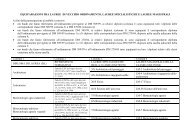
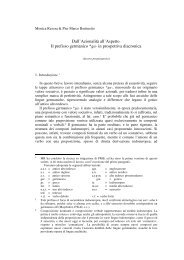
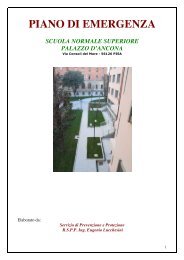
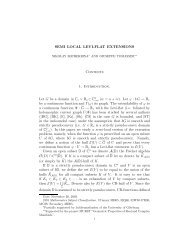
![4. Ghost [Å] vowels in French - Laboratorio di Linguistica](https://img.yumpu.com/49999334/1/184x260/4-ghost-a-vowels-in-french-laboratorio-di-linguistica.jpg?quality=85)


